How to Write a Book Description (+ Book Description Examples)
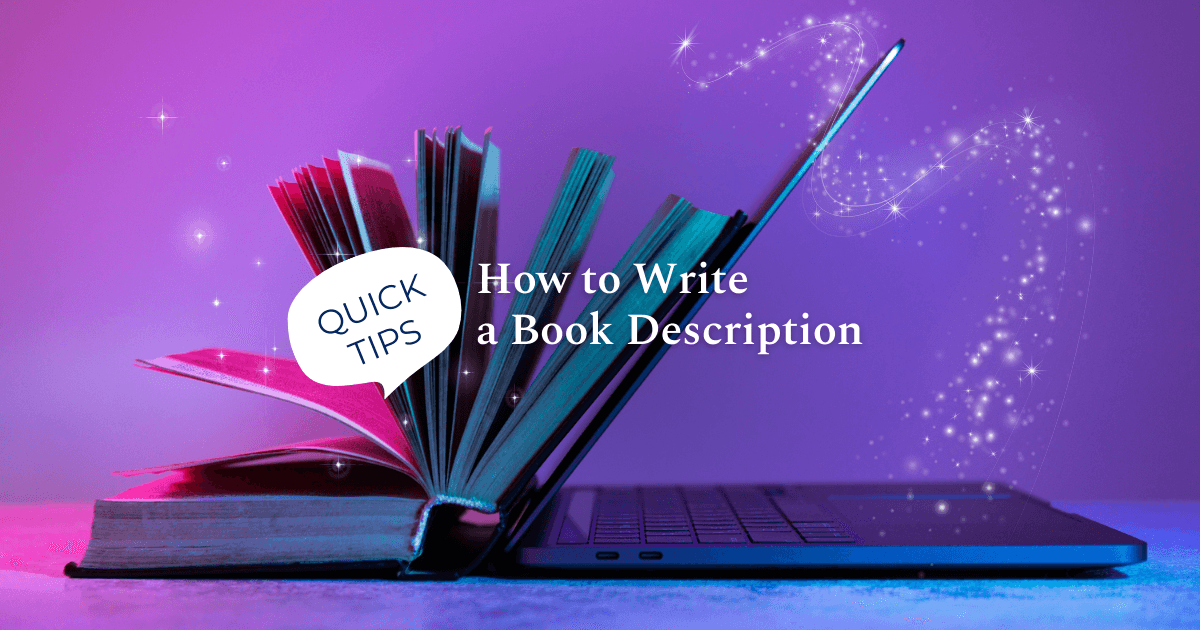
How to write a good book description that sells? Below are nine tips on how to write a book description, plus the best book description examples to help inspire you.
Why is your book description important?
The book description simply answers the question: what is the book about? It’s different from the book blurb that goes on the back of your physical book. Your book description is part of your metadata, which holds your book details for stores and readers to access. And to successfully sell your book, you want to regularly optimize your metadata throughout your publishing journey. Before learning how to write a book description that sells, let’s go over what book metadata exactly is.
What exactly is metadata?
Metadata includes your author name, title, subtitle, series information, language, categories, keywords, reviews, pricing, and description. Accurate metadata helps search engines rank your book in the right queries. It serves as an important book marketing element that helps boost your discoverability.
Along with your book cover, your book description is one of the first things a potential reader comes across. It can convince people to buy your book… Or lose them. That’s why it’s best to know how to write a book description and fine-tune what you can. Here are nine tips to go through –
With PublishDrive’s Book Metadata Generator (part of the Publishing Assistant), you can create optimized metadata in minutes. The tool tackles the technical aspects for you, generating essential components like keywords, Amazon categories, BISAC categories, and even book description ideas. It helps your book get discovered faster by the right readers, all without replacing your creative input.
9 Tips on How to Write a Book Description
1. Check the length of your book description
How long should a book description be? Some say the sweet spot is between 150-200 words. Generally, the shorter your description of the book, the better. But when asking three different experts, we get three different answers. So, I recommend researching the particular genre your book is in. Check Amazon’s top-selling books and see what the norm is, especially those in your genre.
2. Include words or phrases your ideal readers would type out
I shared how metadata helps with your discoverability in search engines. You can sprinkle certain keywords in metadata, especially your book description, to increase the likelihood of your book getting shown. For example, let’s say you wrote a manual about dream interpretation. If someone searches for “about dream symbols,” your book would pop up if you had the phrase “about dream symbols” (or something similar) within your description.

To find out which words or phrases readers are searching for, you’d need to conduct your own keyword research. There are several ways to collect high-traffic keywords for your book, such as directly typing into Amazon’s search engine. I also encourage you to think of your target audience (your ideal readers) and the kind of words or phrases they would type out. You know your content best, especially if you’re in a niche market. What are the overlapping keywords?
3. Use easy language
Even if your book is at a higher reading level, your description should be in consumer-friendly terms. Treat the description like it's an ad – it essentially is. And for ads, the rule of thumb is to use basic writing. It’s easier to sell when your language is easy to understand. To check how complex or easy your writing is, insert your text into the free Grammarly app and check its Flesch Readability Score. This score will give a number from 1 to 100. Scoring between 70 to 80 is equivalent to school grade level 8. Try scoring lower than 60.
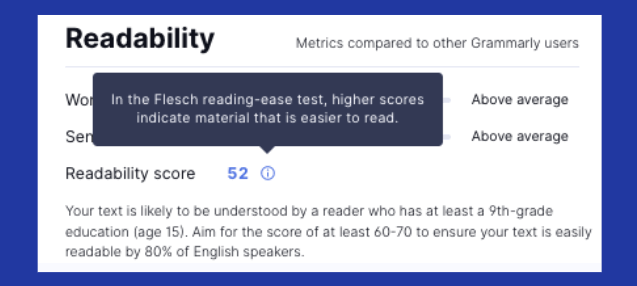
4. Avoid time-sensitive language
For example, refrain from using words like “latest,” “recently” or “coming soon.” You don’t want an outdated book description. That’s more editing work for you in the future. We’re going for timeless.
5. Avoid messy HTML
A good book description is easy on the eyes. Psychologically, simplicity keeps people engaged across various mediums, especially with ads. Limit your HTML to: <i>, <li>, <b>, <p>, <br >, <ul>, <ol>, and corresponding end tags. If you can, avoid hyperlinks.
6. Opt for simplicity
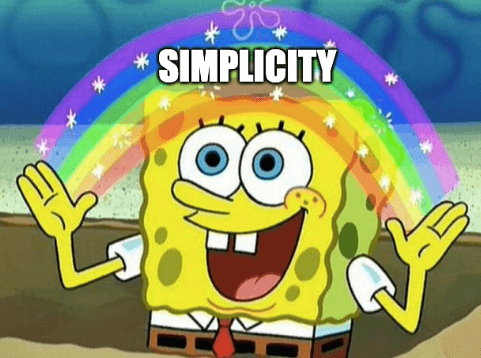
Reading the book description should be a seamless experience. So I emphasize this further: go for a cleaner look. You know the saying: “keep it simple, stupid!” This means getting rid of superfluous words. Make every sentence and every word count. Include paragraph breaks to break up longer blocks of texts. Use shorter paragraphs overall. It’s often a short description of a book that can really pique the interest of a reader.
7. Opt for bullet points
One way to clean up your description is to break up blocks of text by using bullet points or lists. Doing this can add a bit of dynamism to your description while concisely delivering the key messages you’d like to share.
8. Finesse your first few sentences
Bookstores like Amazon display the first few lines of your book description. To make up for this limited space, your first few sentences should be really, really impressive. Add the strongest or most emotional hooks you’ve got. Definitely add any social proof to the front. Social proof takes the form of reviews, media coverage, awards, and more. Got a provocative question? Let’s grab the attention of your audience right away.
Let’s look at book description examples from Amazon. Here is Amazon’s #1 bestselling book, Leigh Howard and the Ghosts of Simmons-Pierce Manor by Shawn M. Warner:

See how the first sentence stacks all the book’s achievements, bolded and underlined?
Take a look at one of PublishDrive’s self-published bestsellers, An Earl By Any Other Name by Lauren Smith:

Lauren’s first bolded line is simple, but packed with everything the reader needs to know about the book. We immediately get information about the main two characters as well as what kind of genre we can expect (a fairytale!)
9. Use an ending hook
Last but not least, end your book with a hook. This is a tactic most commonly seen with fiction books, but nonfiction book descriptions can utilize hooks as well. An ending hook is a cliffhanger that urges the reader to purchase your book to find out what happens. Think of it as your call to action.
I’ve got another Amazon book description for Mistborn: The Final Empire by one of PublishDrive’s indie authors Brandon Sanderson. This description is on the lengthier side. However, the first sentence mentions how over 20 million copies have been sold – we can trust that the book is worth checking out:
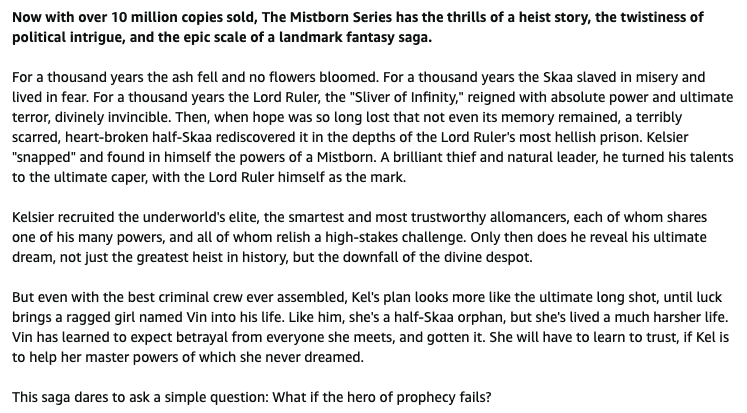
See how Sanderson ends the description: “This saga dares to ask a simple question: What if the hero prophesy fails?” That’s an ending hook.
A few more book description examples
I want to leave you with two more great book description examples. We’ve looked at fiction book descriptions, so here’s a nonfiction one from Amazon’s top bestseller Atomic Habits by James Clear:

This one is lengthy, but it has all the pieces to really sell itself as an exceptional self-help book. It starts off with its strongest proof, breaks down what the reader can expect in bullet points, then ends with a promise.
Here’s another description for Prince of Wolves by PublishDrive’s indie Quinn Loftis:
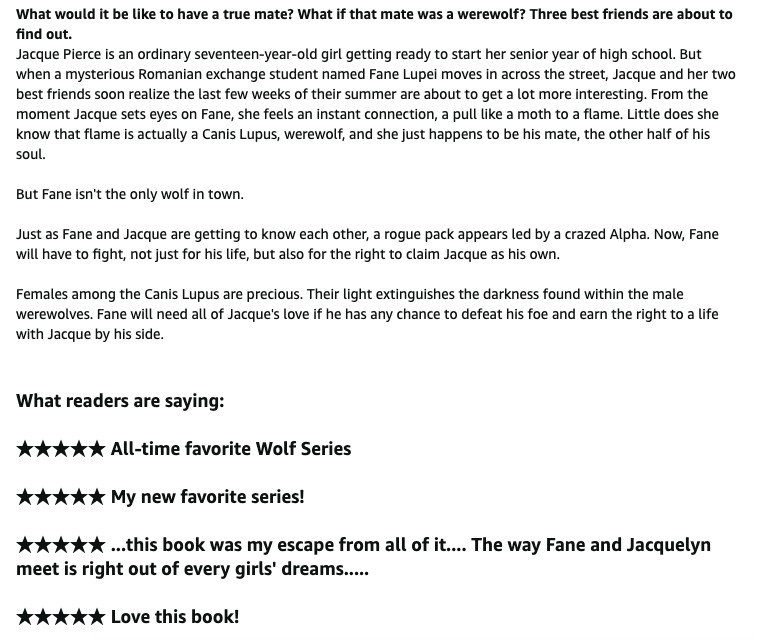
Aside from the fantastic copy, I like how they used “What readers are saying” as social proof. Look, not everyone (especially first-time indies) can win awards or become bestsellers right away. So I think it’s a great idea to highlight some of your favorite book reviews in your description.
Hope this helped. Good luck!
Now You Know How to Write a Book Description… Need More Help?
✅ One dashboard is all you need to sell in thousands of bookstores.
✅ Get support with metadata, royalty reporting, book promotions, and more.
✅ Join published authors who doubled their sales.
✅Publish your 1st ebook free!